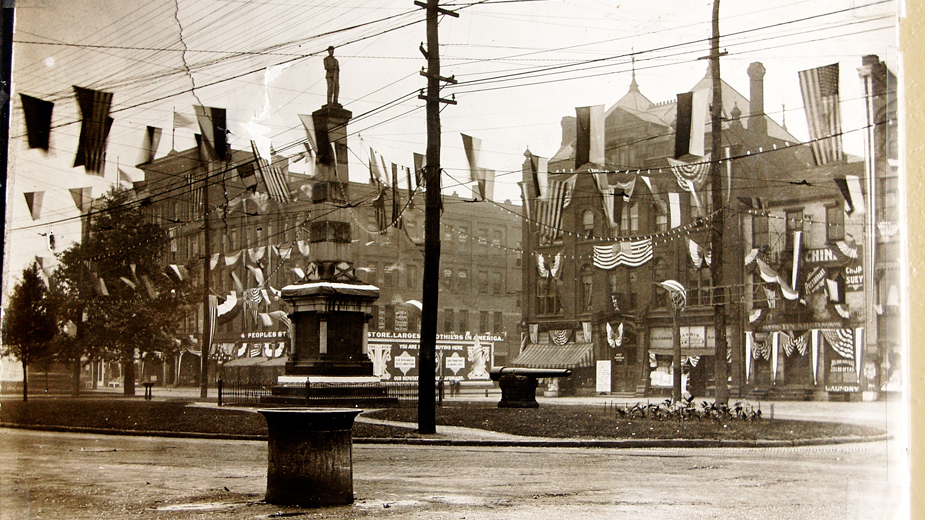Immigrants Who Came for Industry Built New Castle
NEW CASTLE, Pa. – The intersection of Washington and Jefferson streets in the center of downtown New Castle, Pa., is known as Kennedy Square. It was the heart of the original settlement, founded by John Carlysle Stewart in 1798, and remains the heart of the downtown.
“It was a very desolate area and he goes into this land and starts to lay out New Castle with The Diamond at Washington and Jefferson,” says Andrew Henley, executive administrator of the Lawrence County Historical Society.
Stewart, John McWhorter and a small group from New Castle, Del., arrived in a wilderness once home to the Delaware Indians. He named the expanse of grass, hazel bushes and black oaks after his hometown.
Until the 1830s, bridges provided New Castle with the most efficient means of moving people and materials across Neshannock Creek and the Shenango River, but the opening of the Beaver Division of the Pennsylvania Canal provided a much easier and cheaper mode of transportation, making New Castle an important industrial hub. “This became a large stop on the canal,” Henley says.
New Castle became a borough in 1825 and eventually part of the newly created Lawrence County in 1849. Those who formed the county wanted to honor the memory of Capt. James Lawrence, one of America’s best-known heroes of the War of 1812. Lawrence died in battle with the British Navy frigate HMS Shannon in 1813. Among the last words he said were, “Don’t give up the ship!”
“They appropriated the slogan for their campaign to create Lawrence County,” Henley says.
By the late 1840s, two foundries, a rolling mill, several saw, flour and oil mills and a nail factory called New Castle home.
Railroads replaced the canal in the 1870s as new industries emerged, including tin, iron and steel. The need for tin plate in particular provided a ready source of employment for the Irish, Welsh and Italian immigrants who settled in the area.
The Tariff Act of 1890, passed under the McKinley Administration, raised duties on imports by almost 50% and helped entrepreneurs such as George and Charles Greer who opened the New Castle Steel and Tin Plate Co. in 1893.
Among the other notable manufacturing operations were the Shenango Valley Steel Co. and Neshannock Sheet and Tin Plate Co. Many of these operations were later merged into the New Castle Works of the Carnegie Steel Co.

Pictured: The Rosena Furnace, built in 1872, became part of the Carnegie Steel. It closed in 1931.
New Castle boomed in tandem with tin and the rise of heavy manufacturing. The population increased 227% between 1860 and 1870 and 144% between 1890 and 1900. Workers often labored six days a week, but the growth of amusements followed the rise in population during the late 19th and early 20th centuries.
In 1897, Arthur Kennedy and Richard Quay bought a small amusement park in New Castle called Brinton Park. The men, who owned a trolley company, connected their line to the park to increase ridership during weekends.
After it was renamed Cascade Park, it became an enormous attraction. The park featured a roller coaster, dance pavilion, zoo, theater and baseball field. The carousel at Cascade came from Idora Park, another amusement park, in Youngstown. “It really thrived into the 1960s,” Henley says of Cascade. The amusements are gone, but Cascade lives on today as a nature park.
Nickelodeon theaters began appearing in the city in the early 1900s. In 1907, the Warner brothers opened the Cascade Theater, their very first, on Mill Street downtown. The brothers were from Youngstown, but the high price of real estate in downtown Youngstown and many competitors there led them to New Castle.

Pictured: Warner Cascade Palace theater was built in 1907 by the Warner brothers.
The brothers discovered New Castle while on tour exhibiting their only film, an old copy of “The Great Train Robbery,” one of the first classics of cinema. “It was a queer affair,” Harry Warner later said of the Cascade. “We used a salt-herring barrel filled with wet salt for a rheostat and my brother, Sam, the family projectionist, was continually getting shocked.”
Over the years, New Castle established a reputation for food and fireworks. In 1893, Italian immigrant Antonio Zambelli opened the Zambelli Fireworks Manufacturing Co. in the city. The Vitale Fireworks Manufacturing Co. followed in the 1920s. Both companies went on to establish national reputations.
Greek immigrants helped connect New Castle with the wildly popular Coney Island hot dogs. George Papazickos and John Mitsos opened Coney Island downtown in 1925, sparking a craze for their 35-cent dinners. Post Office Lunch and Hudson Lunch also served Coney dogs to hungry residents. “They fed us, the Greek families,” says Anna Mary Mooney, board member of the Lawrence County Historical Society.
Today, New Castle is often referred to as the “fireworks capital of America,” she says, and the “hot dog capital of the world.”
Pictured: Flags adorn The Diamond at Washington and Jefferson Streets on July 4, 1908. Photos courtesy of Lawrence County Historical Society.
Copyright 2024 The Business Journal, Youngstown, Ohio.



